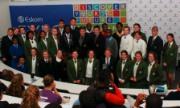
A group of 88 excited and motivated learners from across the Eastern Cape converged at Rhodes University recently to partake in the Rhodes University / Eskom Expo for Young Scientists Grahamstown Regional Final. The learners presented their 64 projects to teams of judges in the hope of reaching the Eskom Expo for Young Scientists International Science Fair (ISF) in Johannesburg in October.
The Eastern Cape was well represented with a group of new schools joining in the fun. Grahamstown Regional Science Fair Director, Anja Fourie said 10 schools were involved this year including three new ones from Queenstown. “It’s so important to encourage teachers and learners from all areas of the Eastern Cape to learn about the Eskom Expo.”
The learners ranged from Grade 7 to Grade 12 and many of the projects were aimed at solving problems that people face in their communities on a daily basis. Projects included research into how water shortages affect community members, the efficacy of homemade soap, how to produce cheap toilet-cleaning products, and how much food is wasted in the average household. After the round of judging, the students were treated to a series of workshops and a guided tour around Rhodes University, followed by a quick-fire science quiz to test their knowledge.
There were two gold, eight silver and 15 bronze medals awarded. “The quality of ideas we see coming through, particularly from the junior grades is impressive. There is a lot of awareness of scientific and technological challenges in our communities here in the Eastern Cape. That comes through more and more every year,” she added.
Winner of the Eskom Award for Best Development project Luphelo Belu was overjoyed to take part in this year’s regional expo. “Being here gave me a sense of the experience, because I had heard about it but wondered what to expect,” he said. Belu, who is in Grade 11 at T.E.M. Mrwetyana Senior Secondary School had explored how members of the Joza community are affected by water shortages. “People can’t bath or shower; they can’t flush toilets or clean properly. I even see the effects of it in school. The kids get chaotic when there’s no water.”
Winner of the Best Energy Project for her research into cost-effective ways of reducing one’s carbon footprint, Zoë Lang said attending the Eskom Expo revealed a great deal about the kind of dedication required to conduct successful science experiments. “We’re learning about the amount of work involved,” she said. “I had to be very precise with my experiments. You have to do things properly and understand the methodologies involved.”
Other prize-winners included Danielle Walker of Victoria Girls’ High School (best project by a female participant for “Do birds have a favourite colour?”), and Iain Macpherson of St Andrew’s College (Best Energy Efficiency Project for “Eco- friendly waterproofing”).
According to Fourie, one of the stumbling blocks to ensuring more students decide to study science, or graduate with a science degree, is scientific method. “This (scientific method) is often not taught properly in schools, or in some cases is not taught at all, and when students get to first year they cannot cope and drop out. The Eskom Expo for Young Scientists teaches scientific method in an interactive and fun way, preparing students for university and the world of research,” she said.
Danie du Plessis, Eskom Senior Manager of Transmission in the Eastern Cape, emphasised the need for young South Africans to embrace the wonders of science. “The main spirit of the Eskom Expo is to get the interest of pupils around the region. Eskom, and the country as a whole, has great need for people with technical skills, and we have a social obligation to create an interest in the scientific fields.”
The Eskom Expo has been offering the opportunity for school children to engage with the fields of science, technology, engineering, mathematics and innovation for the past 30 years. Schools from 31 regions across all 9 provinces are invited to submit projects in 25 categories, giving their learners the chance to shine in front of their peers.
By Sarah-Jane Bradfield
Photo by: Ruan Scheepers
